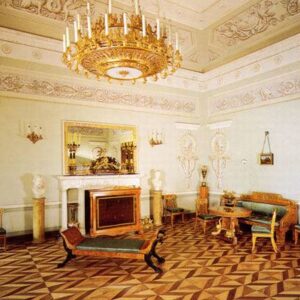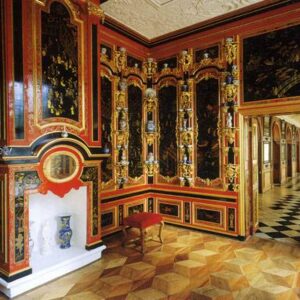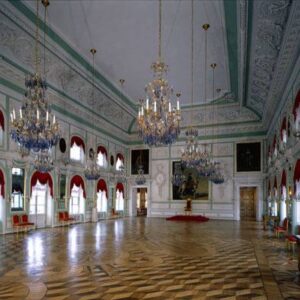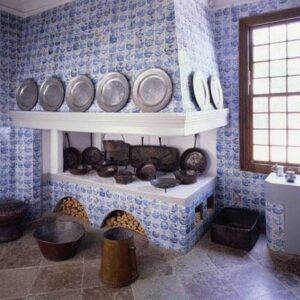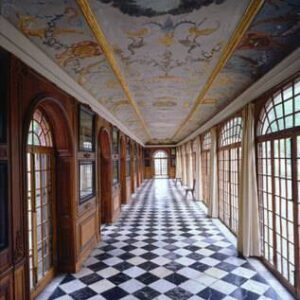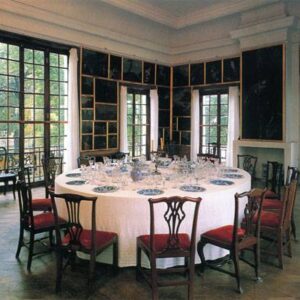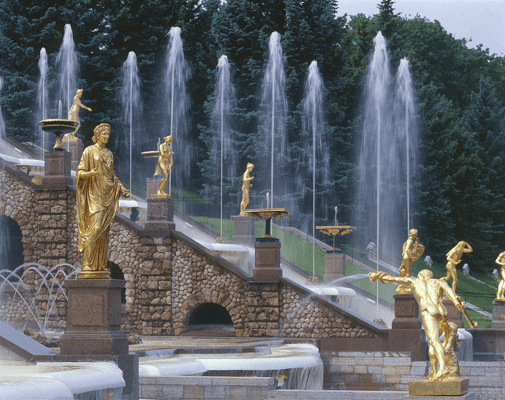
Peterhof was the first of the great Imperial ensembles to be established outside St Petersburg and is definitely “a must-see” for any first time visitor to St Petersburg.
Completely dedicated to the Russian victory over Sweden in the “Northern War”, it is often called the “Russian Versailles” but actually it has surpassed Versailles in many respects: it is a real “kingdom of fountains” with amazing cascades, a variety of unique and playful fountains, Grand Peterhof Palace, and other small palaces.
Peterhof is located approximately 30 km to the south of St Petersburg on the coast of the Gulf of Finland.
It is probably the most famous summer residence of the Russian tsars – and the only official marine residence. Peter the Great wanted to highlight the importance of the fact that Russia now had the access to the Baltic Sea that is why the location was chosen by the Tsar himself.
The façade of the residence faces the sea as most of the guests arrived by sea. Nowadays it is also possible. In summertime, if the weather permits, you can get to Peterhof by hydrofoil. The half an hour journey takes you straight from the Winter Palace to the Summer Palace.
In Peterhof apart from the park which is gorgeous, you can also visit one of the small museums, such as Mon Plaisir (the favorite palace of Peter the Great which he preferred even to the Grand Peterhof Palace) or Marly Palace (inspired by the residence of the French kings) or explore one of the many museums located in the area.
New museums are opened in Peterhof every year, among them being the treasury of Peterhof or the Palace Church.
One of the latest museum’s to be opened is the Tsar’s Amusements. This museum is not very typical of Peterhof because there are a number of new multimedia technologies used in the exhibition. Here you can learn about the receptions that took place in the residence with thousands of guests and as many servants famous even in Europe, about the fountains, the Peterhof theater and many other entertainments.
Even just walking through the gardens is a bright adventure with beautiful statues, fountains, and watery tricks at every corner. Children will enjoy the various trick fountains that abound in Peterhof and this is a nice opportunity to cool off on a hot summer day.
See our Peterhof Video Here…
The Palaces of Peterhof
Peterhof is one of the most famous former residences of Russian Tsars around St Petersburg. It is located on the shore of the Gulf of Finland and was from the very beginning meant for gala festivities of the court. Most people know Peterhof for its stunning fountains. However it is not all! The resident also includes numerous palaces and pavilions. The huge Grand Palace is the compositional center of the ensemble. And there are also smaller palaces, which are also absolutely worth visiting. Here are the most important palaces and pavilions of the Lower Garden that have always been a true attraction for the visitors.

The Grand Palace
The Grand palace is one of the oldest palaces on the territory of Peterhof. It was started by Peter the Great in the early 18th century. The first palace, which got the name of the Upper Palace, was a rather modest building located on the top of the hill with a fine view of the Baltic Sea. However already under the daughter of Peter the Great Elizabeth the palace became a gala residence and in such a way it was used by the Russian emperors till the Revolution of 1917. Since all the Tsars used the Grand palace, there were re-decorations in the building carried out by the most outstanding architects. You will see the Oaken study of Peter the Great and the Oaken staircase, which remind us of the very first Upper palace, as it was called under Peter the Great, Baroque style rooms dating back to 1750’s, the Chesma hall designed in the times of Catherine the Great, which was the favorite room of Catherine and of Nicholas I.
During the WWII Peterhof was occupied by the Nazis who blew the palace up when they were retreating. Whatever they could lay their hands on was plundered, dispatched to Germany or deliberately destroyed. The palace we see today was reconstructed by the Soviet restores. Its interiors help us to imagine how the court lived in those days and actually illustrate all the stages of the life of the palace – from the early 18th century to the turn of the centuries.
Peterhof was the first of the great Imperial ensembles to be established outside St Petersburg and is definitely “a must-see” for any first time visitor to St Petersburg.
Completely dedicated to the Russian victory over Sweden in the “Northern War”, it is often called the “Russian Versailles” but actually it has surpassed Versailles in many respects: it is a real “kingdom of fountains” with amazing cascades, a variety of unique and playful fountains, Grand Peterhof Palace, and other small palaces.
Peterhof is located approximately 30 km to the south of St Petersburg on the coast of the Gulf of Finland.
It is probably the most famous summer residence of the Russian tsars – and the only official marine residence. Peter the Great wanted to highlight the importance of the fact that Russia now had the access to the Baltic Sea that is why the location was chosen by the Tsar himself.
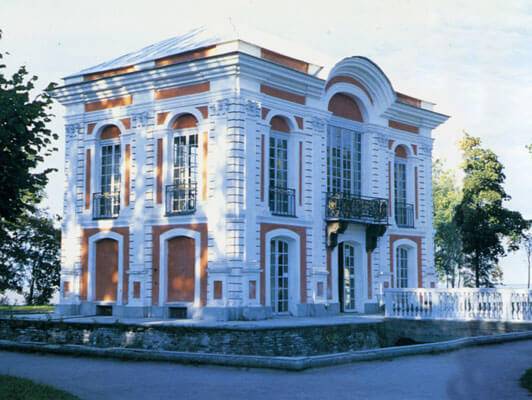
The Hermitage Pavilion
Everybody know the Hermitage museum with its huge and vast collections. However, it is not the only Hermitage in Russia – almost every summer residence of Russian emperors had a Hermitage pavilion for smaller receptions.
The word “Hermitage” comes from the French word “ermite” and means “a place of solitude”.
The detached atmosphere of the Hermitage is emphasized by a deep moat running around the building. In the 18th century the moat was filled with water and only a small drawbridge was used for admission. The most important attraction of the pavilion apart from the paintings decorating the hall is a lifting table for 14 persons. It was made in 1725. At a bell signal the central part of the table with handwritten requests from the guests was lowered to the ground floor and then raised to the upper floor with ordered dishes.
So that the guests could enjoy their feast without the presence of servants. What we can see now is an imitation of Peter’s table. Until Paul I came to power a special armchair was used to lift a monarch to the second floor. The armchair got stuck between the floors when Paul took it. After that it was not used anymore.
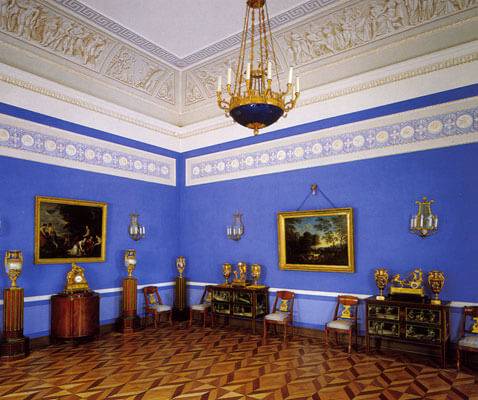
The Catherine Block
This small palace is of great historical importance. It was from here that in 1762 Catherine the Great rushed to St Petersburg to dethrone her husband, hence the name – the Catherine Block. In the second half of the 18th century the palace was used for balls and receptions. In the 19th century it was not used for anything. Only in summer on the graduation day at the Smolny and other institutes (July 1) the Emperor received here the graduate students. The Classical Style is expressed in the interior decor, and first and foremost in the color scheme.
This palace is for visitors with exquisite taste. If you like the Classical or the Empire style, you will definitely enjoy the design of the block. What is more, on display in this palace is one of the most valuable service sets of the entire collection of Peterhof – the Guriev service set, one of the best Empire style service sets produced on the Imperial Porcelain Factory in St Petersburg.



